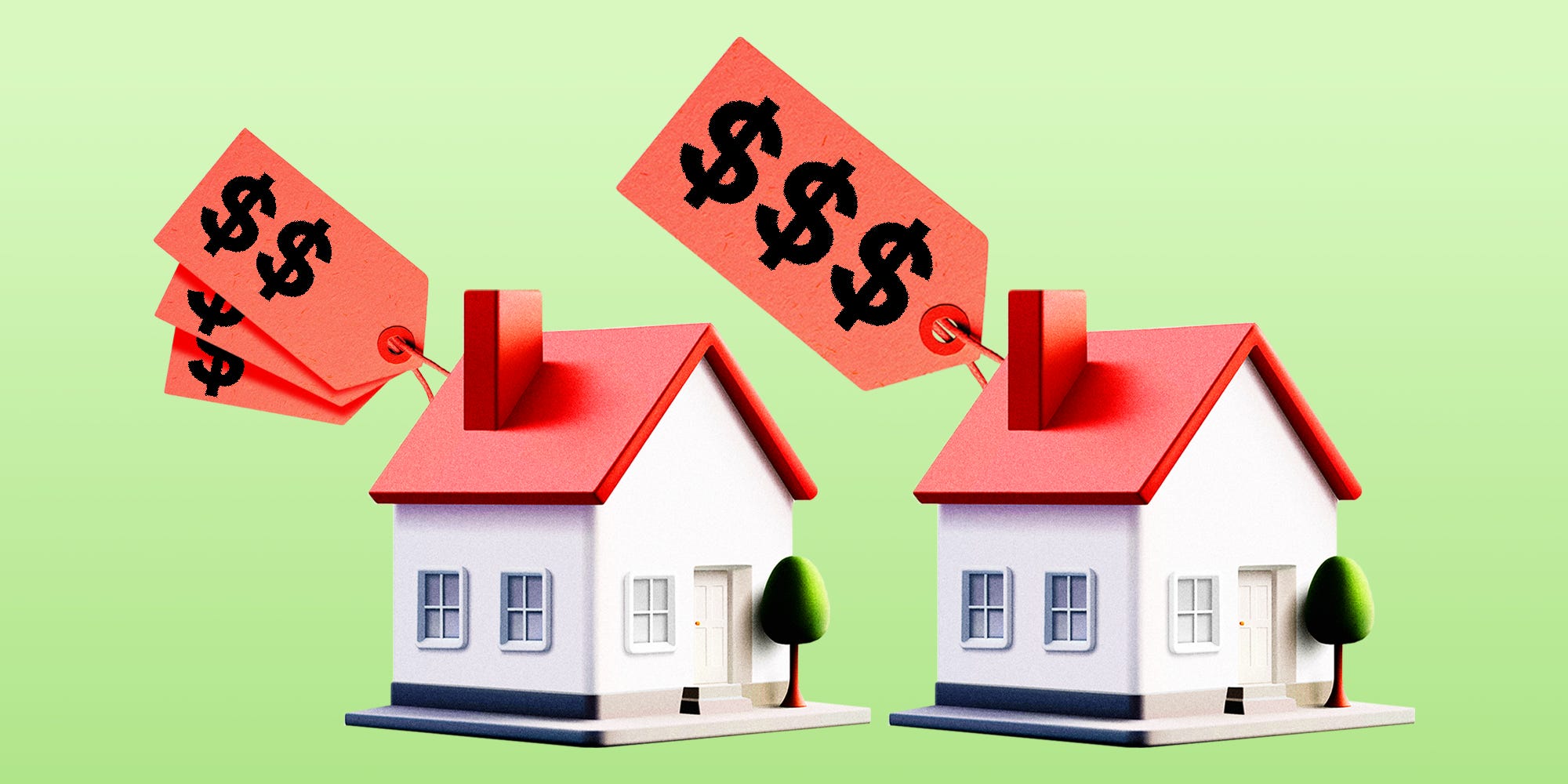
Getty images; Tyler Le/BI
If you haven’t seen it yet, go check out Airbnb, Ticketmaster, Booking.com, or StubHub and behold the magic that is all-in pricing. These platforms, which once had a reputation for stacking on hidden fees as consumers got to the checkout page, are now showing their costs up front.
It’s not because all these companies have had a collective epiphany — it’s because the government is compelling them to be more transparent. On May 12, a new, bipartisan-supported Federal Trade Commission rule cracking down on unfair and deceptive fees went into effect. Per the FTC, the rule “prohibits bait-and-switch pricing and other tactics used to obscure and misrepresent total prices and fees.” It only applies to live-event tickets and short-term lodging, meaning if you’re renting a car or ordering delivery, you’re still in fee hell. But for the sectors in question, it’s the end of sneaky little charges that only show up at the tail end of your shopping journey. Yes, they can still charge you for whatever a “convenience fee” is, but they have to tell you that’s what’s happening from the get-go.
It may seem mundane, but this development is genuinely great. There’s a reason Airbnb and Ticketmaster have trumpeted the moves (without drawing too much attention to why they’re doing it). Disclosing costs up front improves competition, helps consumers make better decisions, and benefits businesses that have decided to do the transparency thing on their own. And people like it.
“Ultimately, this is something that makes common sense — we should be encouraging comparison shopping, especially when prices are high as it is and a lot of people are struggling to get by,” says Adam Rust, the director of financial services at the Consumer Federation of America, a nonprofit. “In any purchase choice, people examine the costs and the benefits, and if the costs are not clear, it’s much harder to make a good choice.”
If companies felt that all-in pricing was a net positive for them, more would do it of their own volition. Instead, they use tactics such as drip pricing and bait-and-switch pricing to lure consumers in with a cheap up-front price before hitting them with a more expensive total. These tactics often get consumers to spend more than they bargained for — or spend anything at all.
Sometimes, you literally show up at the resort when you learn about the fee.
When consumers are shopping, they pay the most attention to the rates that are shown most prominently to them, in other words, the first number they see. As they journey from the original ticket or hotel room price to the final, fee-loaded number, they’re more invested in the purchase. Starting over again means eating some level of sunk cost.
“It makes it harder for the consumer to reverse, because they understand you’re already kind of committed to the transaction,” says Hal Singer, the managing director of Econ One, an economic consulting firm, and an economics professor at the University of Utah. “Sometimes, you literally show up at the resort when you learn about the fee.”
Companies make more money with the add-in fees at checkout. One research paper looked at the case of StubHub, which showed up-front pricing, fees and all, from January 2014 to August 2015. The pricing experiment was so short-lived in part because it cost StubHub money: The researchers found that disclosing fees from the get-go led to a 28% decline in overall revenue. Leaving the fees for the tail end of the transaction increased the quantity and quality of tickets bought — consumers bought more tickets, and they bought better (and more expensive) ones.
“Why do companies do it? Because the revenues go up by a lot,” says Steven Tadelis, an economist professor at the Haas School of Business at UC Berkeley and one of the authors of the StubHub paper. “This whole mechanism takes advantage of this bias that we have, where we’re not taking these fees into account, and it ends up with us making purchases that we otherwise would not have made if we had all the information.”
StubHub executives had hoped consumers would reward them for their transparency, which isn’t what happened, either. They were “never able to get that sweet love that they believed they would get after including all-in prices,” Tadelis says, because consumers didn’t distinguish that StubHub’s seemingly higher prices were because they included fees up front.
If their competitors aren’t forthcoming about prices, even well-meaning companies are hesitant to go out on a limb. They’ll lose out on short-term revenue because consumers will just go for the cheaper-seeming option, and there’s little evidence they’ll get long-term goodwill, either.
When companies have bad news, they want to make it more complicated for customers to deal with.
“This gives bad incentives to companies to try to tack things on at the last moment, because they know that then they could extract more rent from customers,” says Michael Luca, a professor at Johns Hopkins University’s Carey Business School.
Fees also make things more complicated, which is the preferred corporate method for delivering less-than-ideal information. “Basically, when companies have bad news, they want to make it more complicated for customers to deal with,” he says. “When they have good news, they want to make it more transparent.”
I spent a Sunday evening a couple of weeks ago looking at Airbnbs for a trip I didn’t wind up taking. Besides the general excitement of picturing a fun mini vacation, the shopping experience itself was kind of awesome. I was able to set a $500 limit for what I wanted to spend on accommodations and browse accordingly. (This has been an optional search toggle for a few years, but now it’s automatic.) I’m still a little sad that the trip didn’t happen — I’d let myself get a little excited about the prospect of a getaway — but I would be much more annoyed if I had spent hours making spreadsheets comparing prices and mentally baking in a stack of fees only to wind up spending Memorial Day weekend on my couch, as was my destiny.
All-in pricing isn’t something that many companies are likely to do on their own. The StubHub example proves there’s little benefit to it if everyone else isn’t going along. The ability to use drip and bait-and-switch pricing reduces competition and pushes up overall prices, because it stops people from being able to easily comparison shop and seek out the best deals. In its war against what it dubbed “junk fees,” the Biden administration estimated that consumers lost out on billions of dollars a year.
Many companies and industries argue that consumers don’t actually want all-in pricing. They say showing their full costs and fees up front would be too confusing to customers. Or, they say the add-on fees give them options to customize their purchases. This has an element of truth in some circumstances — paying extra to check a bag or pick a seat for a flight is a choice I’d like to have some control over. But I also don’t think I’d be overwhelmed on Expedia or Google Flights if I did get a better sense early on of what options I might be signing up for when I buy a plane ticket, especially in the era of the dreaded basic economy. Also, in many industries, while fees are listed as extra, they’re not optional. U-Haul tacks on an environmental fee that people can’t get out of. The same goes for delivery fees and service fees on food delivery apps, or the plethora of mysterious fees you see as you scrutinize receipts.
“It’s not too hard for a company to know its price schedule and to put that on their website,” Rust says. “But it is difficult as a shopper to go through the process of choosing a product and then putting it in the cart and then initiating payment and then finding out that the price is different.”
Lauren Wolfe, the counsel for Travelers United, a consumer travel advocacy nonprofit, points out that all-in pricing is popular, and again, that the new FTC rule had bipartisan support. “It’s truly one of the few issues in the country everyone agrees on,” she says. Legislation that would clamp down on resort fees recently passed the House, and Wolfe believes it has a good chance of becoming law.
Hidden fees aren’t the biggest issue in the economy, especially amid tariffs and the threat of a recession. But on a day-to-day level, they matter. They’re a perpetual, costly nuisance, the bugs you have to call the exterminator over every spring, even though you keep your home pretty clean and have screens on all the windows. All-in pricing probably isn’t sweeping across the country anytime soon, but in the places where it has to exist, man, is it nice.
Emily Stewart is a senior correspondent at Business Insider, writing about business and the economy.
The post I’ve seen the future of online shopping — and it’s awesome appeared first on Business Insider.




